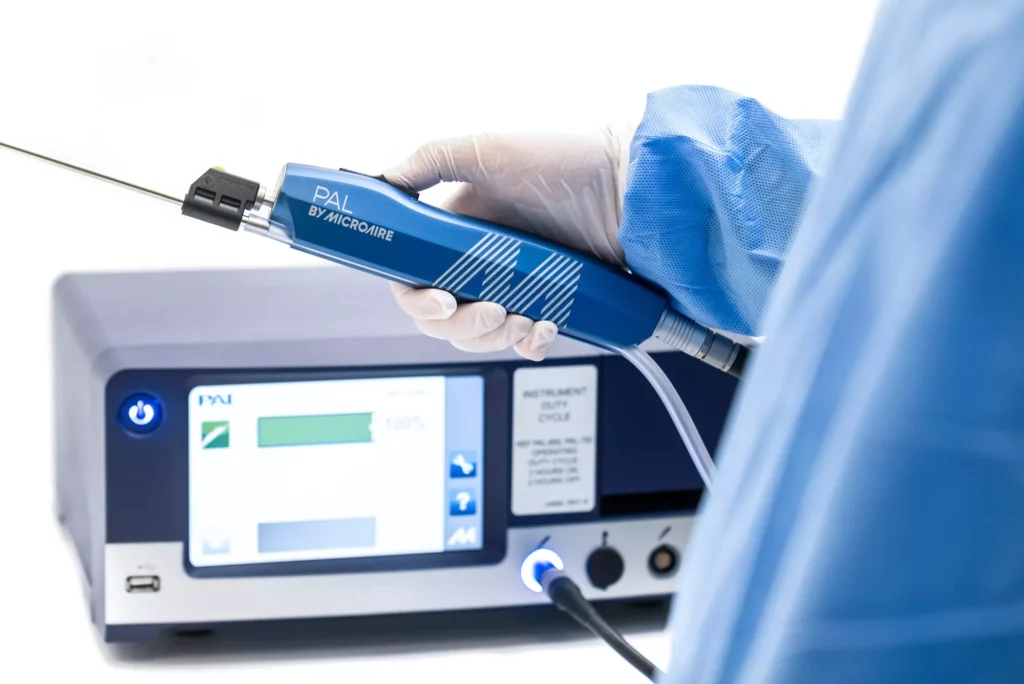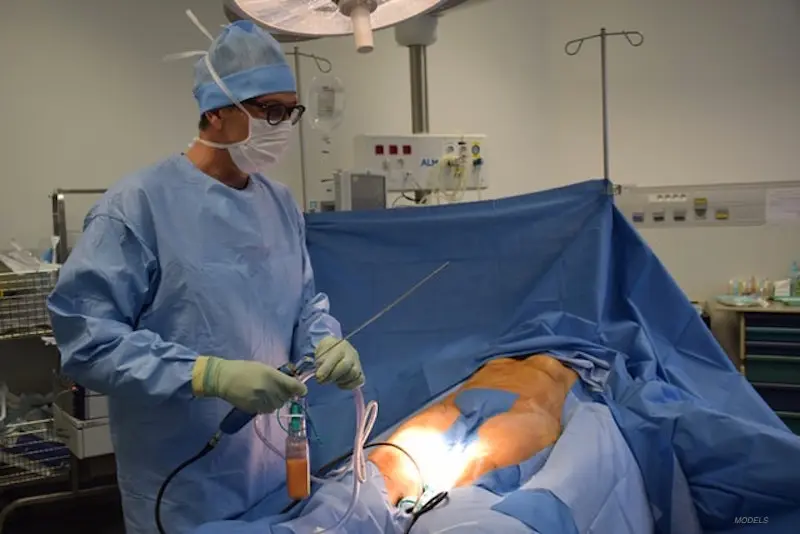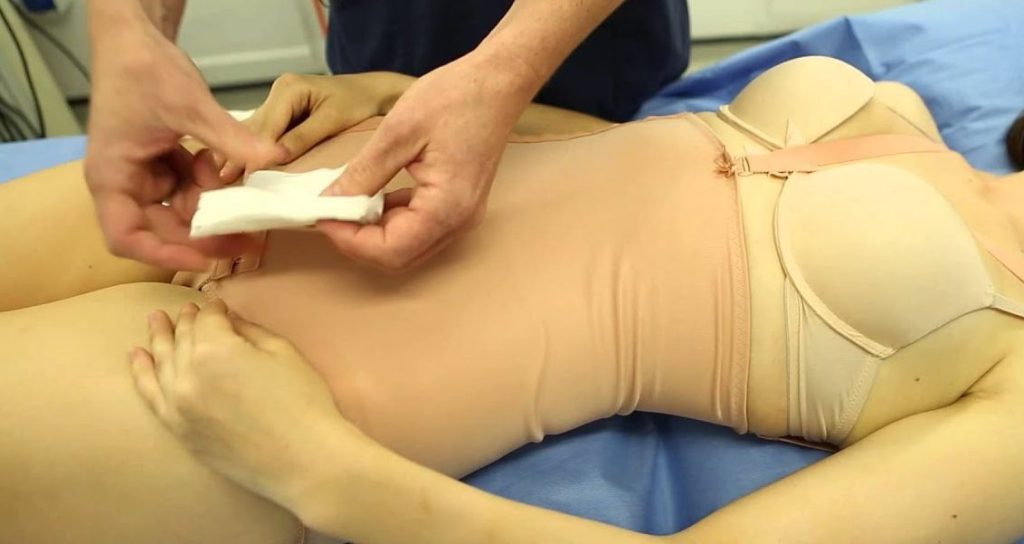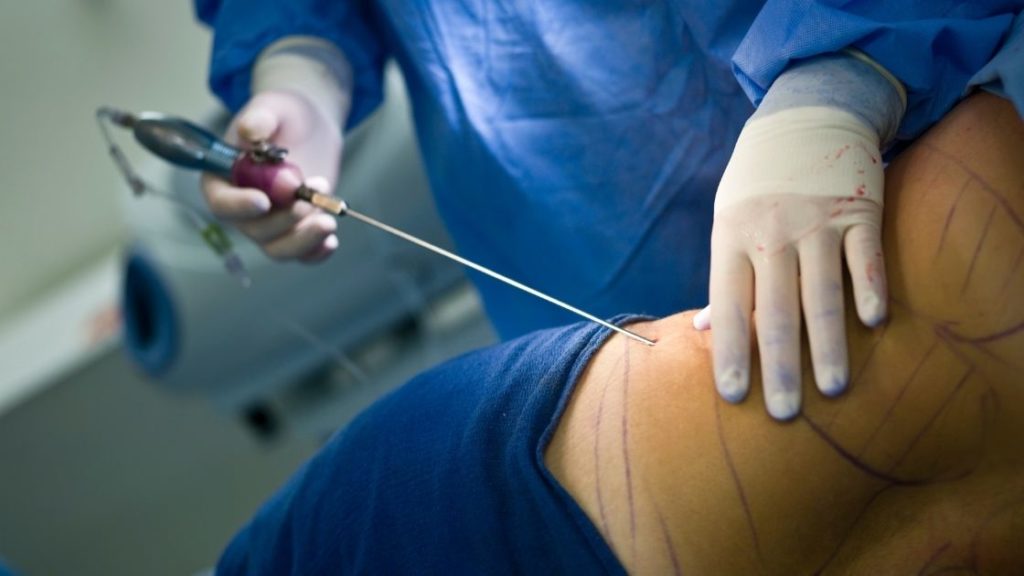Key Takeaways
-
Renuvion skin tightening combines the power of advanced plasma technology to enhance skin firmness. Given its minimally invasive nature and fast recovery time, this procedure can be used on various body parts.
-
Laser treatments rely on focused light energy to stimulate collagen production, addressing wrinkles, skin laxity, and other concerns with customizable options for different skin types.
-
Renuvion provides quicker recovery periods and less scarring in exchange for the laser’s versatile ability to treat various skin problems at once.
-
Deciding between the two ultimately depends on your unique skin concerns, preference for downtime, and long-term goals. Each treatment has distinct advantages depending on an individual’s needs.
-
Working with a qualified cosmetic professional is key to determining your skin type, aesthetic goals, and candidacy for each procedure.
-
The best choice depends on your skin tightening goals, but you will need to take your budget and treatment into account. Additionally, consider how tech-savvy you are.
Deciding between Renuvion and laser-based skin tightening might seem like a daunting task. While both procedures provide noticeable results by tightening and firming the skin, they each operate in different fashions and best serve varying purposes.
Renuvion combines helium plasma with radiofrequency energy, allowing for non-invasive, highly precise results with very little downtime. Similarly, laser-based treatments work by applying heat to the skin, stimulating collagen production. This strategy usually lures in folks searching for non-invasive treatments.
Considerations such as skin type, treatment goals, and recovery time preferences are critical in ensuring you make the right choice. Knowing how each of these approaches works and what it promises allows you to choose the one that better matches your expectations.
Let’s take a look at their differences to determine which is best for you.
What Is Renuvion Skin Tightening
Renuvion, also known as PlasmaLift, is a revolutionary new skin rejuvenation treatment that significantly diminishes visible signs of aging while improving skin elasticity. This advanced treatment provides targeted outcomes, effectively tightening regions prone to sagging or loose skin, ultimately leaving you with a smoother, tighter, and more youthful appearance.
What’s more, this treatment is remarkably versatile. It tackles problem areas on the abdomen, inner and outer thighs, upper arms, back, and even the area under the bra line. It’s an ideal solution for people who want a more enhanced appearance with a natural look—one that doesn’t come from highly invasive surgical techniques.
The appeal of Renuvion lies in its minimally invasive approach. This procedure utilizes small incisions that are sutureless, employing Steri-Strips for closure, which allows for minimal scarring and a fast healing process. This innovative technique is part of the latest surgical technologies in cosmetic surgery.
Most patients are back to their routine in just days, making it a great choice for those with active schedules. If so, you can look forward to enjoying the results in as little as a few weeks. The collagen production it stimulates results in long-term changes to your skin’s texture and tone.
If you want to boost your confidence or recapture a youthful glow, Renuvion is the safest and most efficient option available for both men and women. This treatment is suitable for all skin tones, eliminating the risks of scarring or discoloration, and enhancing your natural beauty effectively.
How Renuvion Works
Renuvion employs the one-of-a-kind combination with science and technology to produce its powerful results. What to expect during a Renuvion treatment? The process starts with helium gas, which is then transformed into plasma energy.
This plasma is precisely controlled under the skin to tighten and contour the specific areas being treated. The procedure kick starts the body’s production of collagen, which gradually helps to tighten and firm the skin over time.
A built-in cooling mechanism protects the surrounding tissues, allowing the plasma energy to tighten and smooth the skin without damage. It’s this combination of precise heat and cooling that makes Renuvion so effective and safe, even on the most delicate of skin.
Key Features of Renuvion
Aside from its unique benefits, Renuvion has a few distinct advantages. It provides stunning results with no hospital time or extended recovery time required. The rapid recovery time and limited scarring make it an ideal option for patients looking for something quick and convenient.
Its versatility makes it perfect for anyone—men, women, and any body type. This ease of use opens the door to anyone looking to rejuvenate their skin to take it for a spin. Whether you’re looking to rejuvenate the abdomen, arms, or thighs, Renuvion provides a customized treatment for unique needs.
Who Can Benefit from Renuvion
The best candidates for Renuvion are healthy adults with mild to moderate skin laxity and realistic expectations. This powerful treatment is ideal for those looking to improve their self-confidence.
It’s highly effective for targeting loose, aging skin, and smoothing out overall texture and tone. Renuvion serves the demand from younger adults who seek a sense of early prevention. It caters to older patients seeking more dramatic improvements.
What makes this treatment so appealing is its ability to provide safe, visible results. Anyone who wants to be more confident in their body will find it particularly appealing.
What Is Laser-Based Skin Tightening
Laser-based skin tightening is a non-surgical cosmetic procedure that uses concentrated light energy to tighten mild to moderately loose skin. The process works by precisely guiding laser energy deep into the skin. This encourages new collagen production, which is the protein that helps skin stay springy.
This procedure is commonly used on areas like the face, neck, or body and offers a way to improve skin firmness without surgery or scars. Numerous patients undergo skin tightening treatment to address the first signs of aging, such as loose skin and fine lines. It still remains one of the most popular treatments to freshen up the face and body.
How Laser Treatments Work
Laser treatments are designed to penetrate the skin’s deeper layers to promote the body’s natural collagen production. Ablative lasers work by removing the top layer of skin. This process encourages the body’s natural healing process and tissue regeneration.
Non-ablative lasers treat deeper layers but do not damage the skin’s surface. This versatility makes the procedure versatile for concerns such as pigmentation, acne scars, or texture issues. For example, someone with uneven skin tone may benefit from non-ablative lasers, while deeper wrinkles might respond better to ablative options.
Key Features of Laser Treatments
Additionally, these laser treatments are extremely versatile, able to treat all skin tones and types. They can address several issues simultaneously, such as laxity and pigment, providing long-lasting outcomes. Most patients see improvements in skin firmness and texture in the first few months.
When paired with a consistent skincare routine, these effects can last as long as a year. Popular technologies such as Ultherapy and combination treatments, including radiofrequency energy, are additionally proving to make outcomes even more successful.
Suitable Candidates for Laser Procedures
Laser treatments work well for individuals with mild to moderate skin laxity who don’t need surgical intervention. A professional skin assessment ensures the right approach, as certain laser types may suit specific skin tones better.
For instance, darker skin tones might require specialized lasers to reduce risks. Overall, the procedure is ideal for those looking to delay more invasive options like facelifts.
Differences Between Renuvion and Laser Treatments
|
Feature |
Renuvion |
Laser Treatments |
|---|---|---|
|
Effectiveness |
Targets skin laxity with lasting results (5+ years) |
Treats severe skin damage effectively |
|
Invasiveness |
Minimally invasive, uses helium plasma and RF energy |
Non-invasive, uses light energy |
|
Recovery Time |
3-5 days with minimal downtime |
Longer recovery with redness/swelling |
Technology and Mechanism Differences
Renuvion works by delivering helium plasma, with the addition of radiofrequency (RF) energy, to contract tissues under the skin’s surface. This method provides targeted heat, stimulating collagen development and tightening skin.
Lasers use concentrated light energy to penetrate and heat the tissues to remove the damaged skin layers. Both promote collagen regeneration.
Renuvion’s extreme specificity reduces soft tissue trauma, so it is an option for patients with mild to moderate laxity. Laser treatments are more effective at treating deep imperfections such as scars or pigmentation.
Treatment Areas and Applications
Renuvion is versatile, treating the face, neck, arms, abdomen and thighs.
Laser treatments are best for smaller, more targeted areas, such as the face and neck, making them especially effective for facial rejuvenation and scar reduction.
While both are safe and effective ways to treat skin laxity and the signs of aging, the uses of these two technologies varies depending on patient needs.
Recovery Time and Downtime
Renuvion treatment provides a much quicker recovery, with most patients getting back to their daily activities within 3-5 days.
In comparison, laser treatments are generally accompanied by more downtime from redness or swelling.
With any procedure, proper aftercare is key to ensuring skin heals its best.
Long-Term Results Comparison
With an excellent skincare regimen, Renuvion results can last for more than five years.
Laser results are heavily influenced by your age and skin type.
Patient testimony shows much greater satisfaction with Renuvion due to its long-term results.
Benefits and Drawbacks of Renuvion
Advantages of Renuvion
Renuvion offers several advantages that make it appealing for skin rejuvenation treatments.
-
Additionally, patients can expect to see visible results in skin tightness and texture right after their procedure.
-
Minimal scarring: Because the treatment uses small incisions, scarring is usually minimal and less visible than other invasive alternatives.
-
Due to its minimally invasive nature, Renuvion is associated with less discomfort in recovery, with the majority of patients requiring just 1-2 days of downtime.
-
The proprietary treatment stimulates collagen production, which restores skin elasticity long after the procedure, maintaining results for years. Providing the patient maintains a proper skincare regimen, results can last 5 years or longer.
-
It’s incredibly versatile and can treat loose skin, fat and cellulite.
Limitations of Renuvion
While Renuvion offers innovative skin rejuvenation options, it’s not without limitations.
-
Limited effectiveness for severe skin laxity: It works best for mildly loose skin and may not provide the desired results for more significant sagging.
-
Although as many as 90% of patients experience noticeable improvement, results vary and will not duplicate the effects of surgery.
-
Potential side effects: Temporary redness, swelling, and bruising can occur after treatment and usually resolve within a few days.
-
In addition, treatments are priced between $3,000 and $15,000, making them potentially pricier than alternatives.
-
Multiple sessions: Best results may take multiple treatments to obtain the desired appearance.
Benefits and Drawbacks of Laser Treatments
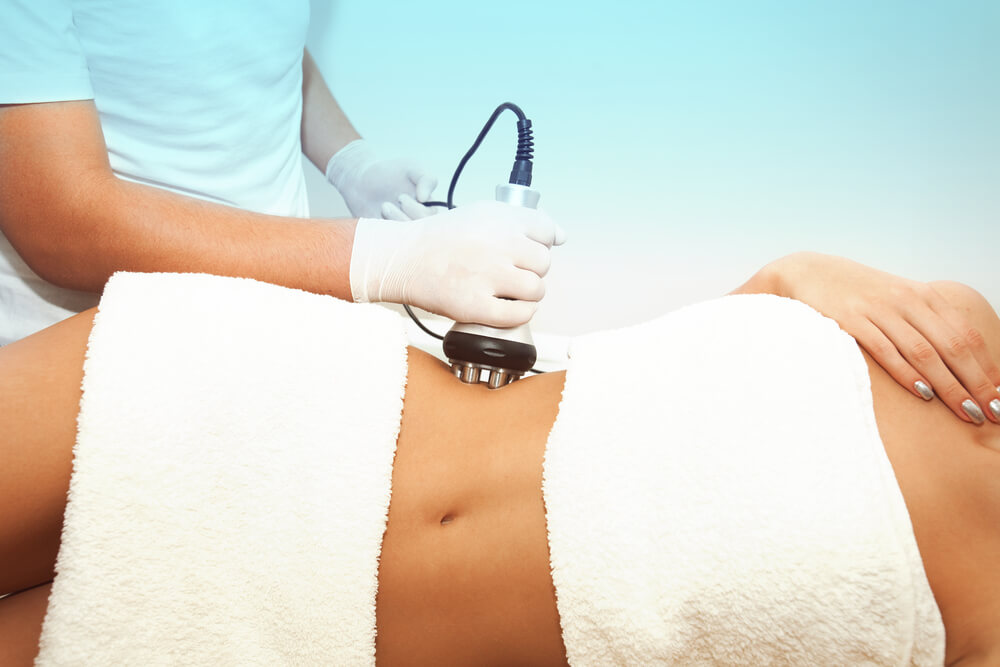
Advantages of Laser Treatments
One of the biggest benefits of laser cosmetics treatments is their versatility, allowing practitioners to address multiple skin concerns simultaneously. These issues include repairing superficial wrinkles, fine lines, acne scars, and pigmented lesions. Laser treatments available at your trusted dermatology practice often require only a single session to significantly reduce the appearance of acne scars, making them an excellent option for skin rejuvenation.
It’s an excellent way to help even out your skin tone. Customization is perhaps the biggest benefit of all. Depending on the type of laser, such as ablative vs. Non-ablative lasers, these can be customized for targeting specific skin concerns.
This versatility allows physicians to personalize treatments based on the patient’s skin type or treatment goals. The results from these procedures are typically permanent, lasting up to five years or longer, making them a smart investment for most patients seeking a youthful appearance.
Precision laser technology enables the treatment of specific areas, promoting smoother, healthier-looking skin over time and enhancing overall skin improvements.
Limitations of Laser Treatments
Though there are advantages in laser treatments, there are disadvantages. After treatment, redness, swelling, and/or flaking are common, and recovery time may be as long as a week. For instance, ablative lasers can involve a week or more of downtime because of the peeling skin.
Costs are high, with an average of $2,000 per session. If you want to get the most impressive results, you’ll have to go through several sessions. Others are less effective on darker skin, which narrows the scope of treatment for people with that complexion.
Laser resurfacing, though effective, lacks the precision of newer alternatives such as Renuvion. Renuvion allows the ability to treat specific areas with little to no damage to the adjacent tissue.
In about 1% of patients, minor scarring or discoloration may develop, but this is very uncommon.
How to Choose Between Renuvion and Laser
1. Assess Your Skin Concerns
Choosing the right skin rejuvenation treatment first begins with knowing your skin. Begin by determining what exact issues you want to address. Are you looking to tackle fine lines, deep wrinkles, or sagging skin? Currently, Renuvion has FDA clearance for use in treating lax skin in the neck and submental region (under the chin). It’s a great solution for sagging in these areas!
It’s perfect for younger individuals or those who have undergone massive weight loss. Laser resurfacing, particularly laser cosmetics technology, is most effective on patients in their 50s and above. Not only does it target deeper wrinkles, but it rejuvenates the skin’s surface beautifully.
Second, think about the severity of your skin laxity. Only slight looseness may be improved with Renuvion, an emerging treatment that tightens loose skin and uses radiofrequency energy to stimulate collagen production. If your issues are more severe, ablative skin rejuvenation treatments may provide more effective outcomes, but they typically require several sessions to achieve results.
Lastly, consider your goals. Compared to laser, Renuvion produces quicker apparent results that further improve with time. By comparison, lasers may require up to a year to fully show their results. Each option serves distinct objectives, so choose according to your desired outcome.
2. Consider Your Skin Type
Your unique skin type and condition will largely dictate whether Renuvion or laser is the best option for you. Renuvion’s technology is best-suited for patients with mild to moderate skin laxity, especially those with thinner skin.
Laser treatments provide extensive versatility and are able to precisely target the skin with different types of lasers, making them suitable on all skin types. They can risk causing pigmentation problems on darker skin tones.
Working with a qualified, experienced cosmetic surgeon, such as board-certified Dr. Duplechain, can help you receive personalized recommendations that address your skin’s specific challenges. For instance, they may advise Renuvion for rapid, focused tightening or laser procedures for deeper, all-over resurfacing.
This individualized approach helps to ensure the procedure is the right fit and reduces the potential for complications.
3. Evaluate Downtime Preferences
Recovery time is another important consideration to balance. Renuvion offers minimal downtime, with the actual procedure taking only 1.5 to 2 hours and an overall fast recovery. This feature makes it a good candidate for anyone with a busy lifestyle or time constraints on aftercare.
By comparison, laser treatments can have extensive downtime, sometimes needing weeks of recovery, particularly for deeper resurfacing. If you don’t have time to spend weeks or months healing, then Renuvion could offer you a more convenient option.
Incredible non-surgical laser treatments are available. Simply ensure that you’re prepared to take the plunge and are able to maintain your results with effective aftercare.
4. Compare Long-Term Goals
Consider where you want to be with your skin long-term. While Renuvion provides immediate tightening, it additionally promotes collagen production for results that last. Laser resurfacing, though effective, usually requires multiple treatments to get comparable results.
Generally, you need a minimum of four to six laser sessions. You’ll likely need touch-ups every few months, adding to the expense and the time commitment. If you would prefer fewer treatments that have more long-term effects, then Renuvion may be a better match for your aesthetic goals.
For individuals looking for more subtle results, or hoping to treat several skin issues at once, laser resurfacing may be the better option.
5. Consult a Professional
In the end, it’s all about having good professional advice. A consultation with an experienced cosmetic surgeon, such as Dr. Duplechain, will help ensure you receive the most appropriate recommendations for your unique needs.
They’ll take a close look at your skin, talk to you about what you want to achieve, and help you consider factors other than cost. Industry experts break down the two technologies and help you understand what you should expect from each Renuvion vs. Laser.
That way, you can choose safely and effectively.
Factors Influencing Treatment Choice
Key Factors to Consider
When deciding between Renuvion and laser cosmetics treatments, several factors come into play.
-
Determine how much tightening you actually need. Do you want major skin tightening or just a softening of the wrinkles?
-
Different technologies work better for varying skin types.
-
Renuvion has a shorter downtime compared to lasers.
-
Cost: Budget is a key factor, with treatment prices differing widely.
-
Provider Expertise: Research providers experienced in your chosen treatment.
Personal Preferences and Lifestyle
Personal lifestyle considerations and comfort can strongly sway the decision. With its minimally invasive approach, Renuvion is often favored by patients seeking a faster recovery.
Patients often brag about immediate changes in skin tightness after just one visit, and patient satisfaction is at an all-time high. If your schedule can accommodate more extensive downtime, laser treatments could be a good option for you.
In terms of recovery, laser procedures usually entail a tougher recovery with redness and swelling persisting for a longer time.
Weighing Pros and Cons
It’s important to weigh the pros and cons. For example, Renuvion runs $2,000–$4,500 per treatment but can provide years of results.
In comparison, laser treatments are cheaper ($500–$2,500 per session) but often need several sessions and a longer recovery time.
Cost and Budget Considerations
The money bit is another huge factor. Renuvion’s upfront cost may seem high, but when compared with long-term results, it tends to be a worthwhile and cost-effective investment.
Conversely, laser treatments look cost-effective at first glance but the cost accumulates with maintenance appointments. Total treatment costs should include aftercare expenses and the cost of any required touch-ups.
Availability of Treatments
Availability for Renuvion and laser treatments may depend on your area. Though Renuvion is becoming more common, it may not be as readily available as laser treatments.
Doing some background research on local providers will help you find the most experienced professionals in your area. Having availability can save you time and keep you on your treatment plan.
Comfort Level with Technology
How comfortable you are with medical technologies is key. Renuvion utilizes J-Plasma, an innovative technology that uses helium plasma powered by radiofrequency energy.
This process provides highly accurate results. Lasers are non-invasive and well understood, so they’re a natural first choice for patients who may be intimidated by newer technologies.
Whatever you decide, confidence in your choice brings peace of mind and satisfaction with the outcome.
Conclusion
If you’re choosing between Renuvion and laser based skin tightening, consider your aesthetic goals and skin type. Keep in mind what option will best accommodate your lifestyle as well. Renuvion provides targeted results with a collagen-renewing focus, whereas laser treatments provide versatility and non-invasive convenience. Both treatments have unique benefits, and knowing what you’re looking for will help you make the choice.
Consultation with a qualified provider will help you receive the best advice for your unique needs. They will be able to guide you on how each treatment will best meet your skin and personal goals. Doing your research and having thorough consultations will help make the process easier and your decision clearer.
Choosing the right skin tightening treatment for you While skin tightening is a highly personal experience, the right treatment delivers enduring confidence and gratification. Start looking at what works best for you today and take that first step toward looking and feeling your best.
Frequently Asked Questions
What is Renuvion skin tightening?
Renuvion combines the power of helium plasma with radiofrequency energy for effective skin rejuvenation. This non-invasive procedure penetrates deep into the skin, targeting collagen production to achieve a youthful appearance. Typically performed under local anesthesia, it effectively treats lax skin around the neck, abdomen, and arms, offering a rejuvenated skin look without the need for surgical skin tightening.
How does laser-based skin tightening work?
Laser-based skin tightening, a popular non-invasive skin rejuvenation option, involves heating the skin with highly focused light energy to stimulate collagen and improve skin laxity. This treatment primarily targets the face, neck, and back of the hands, offering a youthful appearance without surgery.
What are the key differences between Renuvion and laser treatments?
While Renuvion is a minimally invasive treatment that works much deeper under the skin, laser cosmetics technology offers non-invasive options, only targeting the very surface layers. Renuvion provides quicker results with some downtime, while ablative skin rejuvenation takes more time and sessions but involves no recovery.
Which treatment is better for loose skin?
Renuvion is best suited for moderate to severe skin laxity, offering a youthful appearance for those seeking dramatic results. In contrast, laser cosmetics technology may be better for individuals looking to address mild to moderate skin laxity and improve overall skin texture and tone. Ultimately, the decision will depend on your skin concern and desired outcomes.
What are the risks of Renuvion?
Side effects of Renuvion, a popular skin rejuvenation option, include temporary swelling, bruising, and redness. Scarring or burns are rarely possible if not performed by a qualified cosmetic surgeon, emphasizing the importance of selecting an experienced provider.
Are laser treatments safe for all skin types?
Most lasers, particularly those used in laser cosmetics technology, only work well on lighter skin tones. Conversely, many lasers can pose risks for pigmentation irregularities and can’t be safely used on darker skin types. Discuss your skin concern with your provider to ensure that the skin rejuvenation options are safe and effective for your needs.
How do I decide between Renuvion and laser skin tightening?
Consider your skin concerns, desired outcomes, and the recovery time you can manage. Renuvion is excellent for deep skin tightening, offering faster results, while laser cosmetics technology is perfect for targeting the surface with minimal downtime. Consult a qualified cosmetic surgeon to explore the best rejuvenation options tailored to your needs.





